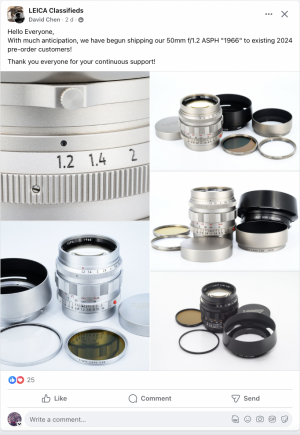Slumgullion
Established
In truth, I can mostly live with the onion rings. I was more meaning the focus and recompose system of a rangefinder doesn't always agree with a lens that has such severe field curvature and focus fall-off. Through-the-lens systems on a digital Leica w/an electronic finder would yield better results (my Sony A7RII works, but the filter stack further exacerbates the curvature and weak edge performance).In a digital monochrome file you can more easily select a luminance range, apply a mask and blend to eliminate the onion rings. You can do it from scans, but it works less well on, just from experience. Of course with 400 or nigher speed film you don’t usually have the resolution to show them. Just pandering to my own personal peculiarity, but the option is there.
The lens has its charms, but I think I need a break from it. I've been spoiled by the Voigtlander f/1 and it's more even performance.
Also, and unrelatedly, I have been working through a 100' roll of Fomapan 400 and I am very excited to move on from it. It has a flaw in the emulsion that runs horizontally through all 100'. Yes, I can clean it up, but It's harder to do that in some images...and it's been zapping my joy.
Last edited:
Slumgullion
Established
And...just to freak you out (okokok...this is too much onion ring for me):In a digital monochrome file you can more easily select a luminance range, apply a mask and blend to eliminate the onion rings. You can do it from scans, but it works less well on, just from experience. Of course with 400 or nigher speed film you don’t usually have the resolution to show them. Just pandering to my own personal peculiarity, but the option is there.
 Jenny by Jim Fischer, on Flickr
Jenny by Jim Fischer, on FlickrLeica M5, LLL 50mm f/1.2 '1966,' Fomapan 400 @ 200, Xtol 1:1...handheld at 1/8 of a second.
sojournerphoto
Mentor
They’re having a party in that one!And...just to freak you out (okokok...this is too much onion ring for me):
Jenny by Jim Fischer, on Flickr
Leica M5, LLL 50mm f/1.2 '1966,' Fomapan 400 @ 200, Xtol 1:1...handheld at 1/8 of a second.
Just wanted to say that I’ve been enjoying your Foma 400 pictures.
Nothing that a good Fortran program running scene segmentation, cell recognition, and smoothign algorithm could not fix.And...just to freak you out (okokok...this is too much onion ring for me):
Jenny by Jim Fischer, on Flickr
Leica M5, LLL 50mm f/1.2 '1966,' Fomapan 400 @ 200, Xtol 1:1...handheld at 1/8 of a second.
Just like a piece of code my wife had me write almost 30 years ago for her 1MPixel microscope camera to do cancer cell recognition.
Slumgullion
Established
Thanks! I like Foma 400…especially considering the price. I’ll probably buy another 100’ at some point. I’m just annoyed with it right now.They’re having a party in that one!
Just wanted to say that I’ve been enjoying your Foma 400 pictures.
dourbalistar
Buy more film
Is that a burger joint sign in the background? I think that's where all the onion rings came from.And...just to freak you out (okokok...this is too much onion ring for me):
Jenny by Jim Fischer, on Flickr
Leica M5, LLL 50mm f/1.2 '1966,' Fomapan 400 @ 200, Xtol 1:1...handheld at 1/8 of a second.
Slumgullion
Established
Hahahaha! It is. Well seen. In fact, I ate a hamburger right after I took this photo.Is that a burger joint sign in the background? I think that's where all the onion rings came from.
Duofold RF
Well-known
Your $50 dollars Nikkor 50mm f3.5 out performed this $2K onion ring kingHahahaha! It is. Well seen. In fact, I ate a hamburger right after I took this photo.
Slumgullion
Established
Your $50 dollars Nikkor 50mm f3.5 out performed this $2K onion ring king
Excuse me! It was $55! Hahahaha
Freakscene
Obscure member
Of course, but Adobe’s smoothing algorithm is much more effective and sophisticated than I can write, and can be set to fade to the edges, or to be even, or any number of things. But anyway, I’ll go back to searching for photos online from the Noct-Nikkor to decide what I think of its out-of-focus rendition and/or how it renders specular highlights in the out of focus.Nothing that a good Fortran program running scene segmentation, cell recognition, and smoothign algorithm could not fix.
Just like a piece of code my wife had me write almost 30 years ago for her 1MPixel microscope camera to do cancer cell recognition.
Marty
@Freakscene On the M Monochrom- when my code applies the Gamma curve it takes the 14-bit raw value and scales to 16-bits, changes the DNG fields to output 16-bit significant values. The idea is to avoid collisions, and have a reversible pixel.
 GAMMA by fiftyonepointsix, on Flickr
GAMMA by fiftyonepointsix, on Flickr
Same code that I added the column restoration algorithm for the CCD.
Do the newer versions of Lightroom or other allow this type of conversion?
 GAMMA by fiftyonepointsix, on Flickr
GAMMA by fiftyonepointsix, on FlickrSame code that I added the column restoration algorithm for the CCD.
Do the newer versions of Lightroom or other allow this type of conversion?
Freakscene
Obscure member
@Freakscene On the M Monochrom- when my code applies the Gamma curve it takes the 14-bit raw value and scales to 16-bits, changes the DNG fields to output 16-bit significant values. The idea is to avoid collisions, and have a reversible pixel.
GAMMA by fiftyonepointsix, on Flickr
Same code that I added the column restoration algorithm for the CCD.
Do the newer versions of Lightroom or other allow this type of conversion?
Yes, but I think it happens in Adobe Raw. The MM files were mostly ok, and when I expanded them out to 16 bits they looked very good. The 12 bit files from the 246 drove me insane. The M10M and M11M seem to output 14 bit natively but Adobe Raw expands them to 16 bit without any apparent problems.
That’s not what I’m interested in. I doubt I could write a script to identify the specular highlights to the exclusion of other areas of the same tone, smooth them and make them slightly tonally graded from the centre to the edge but not blur the edges. Lightroom can do that without any trouble.
Last edited:
Freakscene
Obscure member
I have to say I am surprised to see this on relatively coarse grained film. That’s some outSTANding work.And...just to freak you out (okokok...this is too much onion ring for me):
Jenny by Jim Fischer, on Flickr
Leica M5, LLL 50mm f/1.2 '1966,' Fomapan 400 @ 200, Xtol 1:1...handheld at 1/8 of a second.
I know- I spent the 1980s developing image processing algorithms for digital imagers. It's fun, you get to see the results. In the 90s- went on to Optical Networks, and depended on my Wife to task me with image processing. These days- image processing algorithms just for my Leica DNG files. Just to relax.Yes, but I think it happens in Adobe Raw. The MM files were mostly ok, and when I expanded them out to 16 bits they looked very good. The 12 bit files from the 246 drove me insane. The M10M and M11M seem to output 14 bit natively but Adobe Raw expands them to 16 bit without any apparent problems.
That’s not what I’m interested in. I doubt I could write a script to identify the specular highlights to the exclusion of other areas of the same tone, smooth them and make them slightly tonally graded from the centre to the edge but not blur the edges. Lightroom can do that without any trouble.
But I'm not spending $2K on this lens just to write code.
Last edited:
Slumgullion
Established
 Jenny on Her Bday by Jim Fischer, on Flickr
Jenny on Her Bday by Jim Fischer, on Flickr Jenny on Her Bday by Jim Fischer, on Flickr
Jenny on Her Bday by Jim Fischer, on Flickr Jenny on Her Bday by Jim Fischer, on Flickr
Jenny on Her Bday by Jim Fischer, on FlickrSony A7RII, LLL 50mm f/1.2 '1966.'
Erik van Straten
Mentor
filmtwit
Desperate but not serious
Slumgullion
Established
 Stranger by Jim Fischer, on Flickr
Stranger by Jim Fischer, on Flickr Stranger by Jim Fischer, on Flickr
Stranger by Jim Fischer, on FlickrLeica M7, Light Lens Lab 50mm f/1.2 '1966,' Cinestill 800T.
 Pigeon by Jim Fischer, on Flickr
Pigeon by Jim Fischer, on FlickrLeica M7, Light Lens Lab 50mm f/1.2 '1966,' Ilford HP5+, Xtol 1:1
Slumgullion
Established
 Silvershot Vineyards by Jim Fischer, on Flickr
Silvershot Vineyards by Jim Fischer, on Flickr Silvershot Vineyards by Jim Fischer, on Flickr
Silvershot Vineyards by Jim Fischer, on Flickr Pinot Noir Vine by Jim Fischer, on Flickr
Pinot Noir Vine by Jim Fischer, on FlickrLeica M7, Light Lens Lab 50mm f/1.2 '1966,' Fuji Pro 400H
Last edited:
Slumgullion
Established
Share:
-
This site uses cookies to help personalise content, tailor your experience and to keep you logged in if you register.
By continuing to use this site, you are consenting to our use of cookies.




